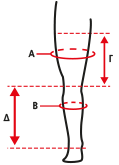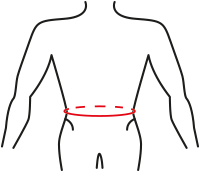"COMPLEX KAFO" LUMBOFEMEROAL AND TIBIAL ORTHOSIS
Code 06-2-105
The orthosis consists of a four-part construction. lumbar, femoral, tibial, and "Drop Foot" All the sections are interconnected with metal high-quality, durable metal struts.
a) Lumbar section
The belt is made out of "Active Space II" fabric, which is a combination of polyurethane, externally lined with "Polyamide" and internally lined with "Terry." The fabric is durable, hypoallergenic, anti-sweat and breathable. The two self-grip straps adjust the level of support in the abdominal area and achieve stabilization of the orthotic.
b) Femoral section
Made out of "Active Space II" fabric. The three self-grip non-elastic foam straps stabilize the orthotic in the proper position. The hip joint features a polycentric "ROM" mechanism for regulation of flexion and extension, with a choice of positions at 15° increments:
• Flexion: 0° to 120°
• Extension: 0° to 90°
• Hyperextension: 0° to 30°
c) Tibial Section
Made out of "Active Space II" fabric. The three adhesive self-grip straps stabilize the brace and achieve proper fit. Between the femoral and tibial sections, there are two polycentric mechanisms for regulation of knee flexion-extension (bilaterally) by 20 ° increments.
• Flexion: 0° to 110°
• Extension: 0° to 130°
There are also two foam pads for protection of the condyles on the knee area,
d) Foot Section
Features integrated shoe brace made out of carbon fibers which keeps the foot in a neutral position in the event of "drop foot." Recommended for patients weighing up to 80 kg.
Available in both left-sided and right-sided.
Available Colors
Available Sizes
Type
Tech Specs
| Size | small | medium | large | x-large |
| Circumference of thigh A (cm) | From 44 to 75 | |||
| Circumference of thigh B (cm) | From 34 to 55 | |||
| Length of thigh section (cm) C | 21,5 | 25,5 | 28,5 | 28,5 |
| Length of tibial section to the foot (cm) D | 42-47 | 42-52 | 42-55 | 50-61 |

| Size | small | medium | large | x-large |
| Foot length (cm) | 22 | 24 | 26 | 28 |
Suitable for a waist circumference of 75cm to 125cm

Indications
- Severe hip-knee instability
- Postoperative rehabilitation of the patellar joint
- Muscle spasm in the hip-knee-ankle
- Return to ambulation following a neurological condition
- Polymyelitis - hip pain




